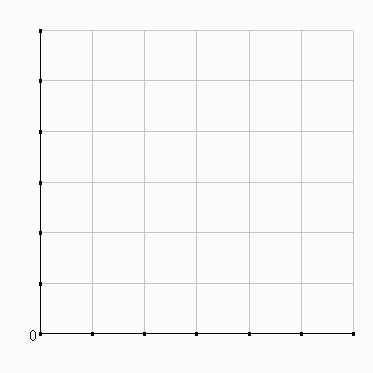| The utility/production parallel: | |
| U = U(X,Y,...) | Q= Q(K,L,...) |
| U is not quantifiable, so we never compute its value | Q IS quantifiable, so we do compute it |
| Constant U => indiff. curves | Constant Q => isoquants |
III. THEORY OF THE FIRM: PRODUCTION AND COSTS
A. PRODUCTION THEORY
2. PRODUCTION IN THE LONG RUN
Now all inputs can be varied--here, both K and L
a. RESOURCE COMBINATIONS AND ISOQUANTS
Isoquant: a curve showing all the various efficient input combinations capable of producing a specified amount of output.
| The utility/production parallel: | |
| U = U(X,Y,...) | Q= Q(K,L,...) |
| U is not quantifiable, so we never compute its value | Q IS quantifiable, so we do compute it |
| Constant U => indiff. curves | Constant Q => isoquants |
| Oxy headbands Note the difference vs. U's: we attach an actual Q-level to each isoquant. |
 |
Slope of Qo:
Geometry: DY/DX = DK/DL
But what does that actually tell us about the production process?
| Consider 2 points on Qo: L K Q From a to b: ? DK = ? ? DQ = ?
|
 |
Note from the example, moving from a to b: we see that if we increase L by 1 unit, the move back to Qo (down) tells us the amount of K we can substitute for and still produce the initial Q.
Size of slope Ex: DK/DL = 3 means that the firm could exchange 3K for 1L without losing any output since the 1L gained is just as useful as the 3K lost.
This substitution rate = the...
Marginal rate of technical
substitution (MRTS): the maximum amount of input Y that a firm is able to give up for
another unit of input X without losing any output.
Don't leave the "T" out--it distinguishes
inputs from outputs:
MRS tells you how much a good is worth to a consumer
MRTS tells you how much an input is worth to producer
Example here: mrts=3=> 1l is worth 3k.
MRTS tells us the trade-off of labor for capital that a firm is willing to make since output is unaffected.
Here: MRTS = 3 => the firm is able to give up 3K for 1L.
MRTS tells you the firm's value of input X relative to Y
It turns out that this ability to substitute L for K is related to the comparative productivities of the two inputs.
MPL/MPK tells us how productive another L is compared to K
Ex: Headband productivity: MPL = 6; MPK = 2 headbands
MPL/MPK = 6/2=3
1 more L is as productive as 3K.
+1L --> DQ= +6
- 3K --> DQ = -3x2 = -6
Net DQ=0
This suggests that MPL/MPK should determine the slope of Qo
It does:
DQ = MPL.DL + MPK.DK
Along Qo, DQ = 0 =>
-MPK.DK = MPL.DL
Rearrange terms:
|-DK|
MPL
-------- = -------- ( = MRTS)
| DL|
MPK
Lefthand side: size of slope of Qo
Righthand sied: productivity of L compared to K.
The logic:
| General case: | | | Example here: | |
| MPL = output gained from an extra L | | | MPL = 6 q | |
| MPK = rate output falls when giving up K | | | MPK = 2 q | |
| | | |||
| => MPL/MPK | | | 6q/(2q per K) | |
| = total K you can give up for 1L w/o losing output | | | 3K for 1L | |
| = |-DK/DL| (the size of the slope of Qo) | | |
The more productive (i.e., valuable) labor is
compared to capital, the more capital a firm can give up to get that labor.
So Qo will be steep when L is valued highly compared to K, flat when L
is not so highly valued compared to K.
A key property of isoquants:
Isoquants are convex to the
origin, reflecting a diminishing marginal rate of technical substitution.
| Consider 2 points on Qo (b with more L and
less K than a): ? Why would you expect L to be more productive at point a than point b? Convexity rests on the law of diminishing marginal returns Convexity => L becomes progressively less effective as a substitute for K |
 |
Example of diminishing MRTS:
Q = BoKBkLBl
MPL
Bl(BoKBkLBl-1) Bl K
--- = ------------- = --- ---
MPK Bk(BoKBk-1LBl)
Bk L
| Example: Q = 8L1/2K1 ? MRTS formula?
|
 |
|||||||||||||||
b. INTERPRETING ISOQUANTS
Note: Inputs = factors of production
(1) factor intensities
Pertains to factor combinations in production
Example: capital per worker (K/L)
| Consider 2 points on Q1 (b with more L and
less K than a): ? which is more k-intensive? Production technique a is capital intensive relative to b. ? Rank factor intensities a..e: Useful in
|
 |
(2) RETURNS TO SCALE
Pertains to movements between
isoquants, holding factor intensity constant.
All inputs are changed in the same proportion => changing the scale
of operations.
3 possibilities:
%DQ = %DScale => CRTS
%DQ > %DScale => IRTS
%DQ < %DScale => DRTS
| Example: Consider 3 input cominations: K L 3 products:
|
 |
Why does this matter?
--optimal firm size: feasibility of competition
--resource productivity: up L productivity => up real wage
2 sources: +K/L and E/S
Example: Cobb-Douglas:
See worksheet
| %DL=100 | %DK=100 | %DScale=100 | ||||
| BL | BK | %DQ | %DQ | BL+BK | %DQ | RTS |
| 1/4 | 3/4 | |||||
| 3/4 | 3/4 | |||||
| 1/4 | 1/4 |